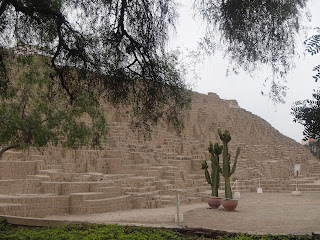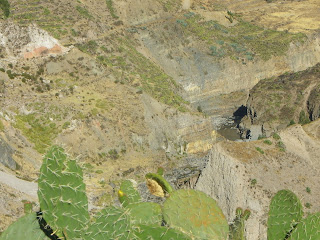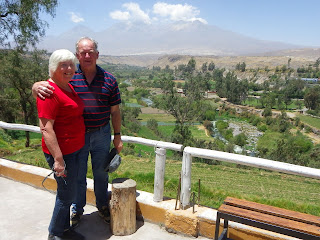On our final day we visited two great archaeological sites in Lima. Our first was an easy walk from our hotel to the Huaca Huallamarca. We were greeted at the entrance by the hairless Peruvian dog.
The museum had an interesting display dating from the Lima people from 200BC to 200AD along with the other periods.
A female Mummy dating from about 1200 AD. There were 4 children also found along with pots, textiles and other items.
Mummy and headdress from 1300 AD
Mask used in burial rituals
The Funerary bundle. These had a false head, a wooden nose, a red face, hair of vegetable fibre and cotton fibre for clothes. The outer layer has been replaced. Dates from 1200 AD.
As we walked up the ramp from the museum to the actual site we were greeted by Hugo. Just a few hairs on his head! The site had great objects in place rather than all off at a distant museum. There was a ticket seller, two armed guards, a gardener, a toilet attendant, the dog and the two of us!
Funerary bundle in situ.
A wonderful archaeological site.
Like a family plot!
Juxtaposition of the old and new Lima.
Gail at the pyramid. It is made of mud bricks and dates from 200 BC.
An overview of Huallamarca.
The pyramid was in use for a range of purposes. Originally religious but later as a cemetery and for use as housing and administration
The periods covered were the Lima people from about 200 BC to 200 AD , the Wari from about 500 AD to 900 AD, the Senorio Yshmay from 900 t0 1470 and finally the Inca from 1470 to 1532. It must have been just too large for the Spanish to build a church over it!
We walked through the parks and then went by taxi to Huaca Pacllana another Pre Columbian pyramid.
The scale of this was immense. You can only visit with a guide as restoration work is underway.
It has been eroded over time but is still imposing.
They used figures to demonstrate aspects of the site. Man making bricks.
The tour took us to the top of the complex.
Figures making offerings.These are from Yshmay people.
Yshmay figure from attached museum.
Object from Lima period.
There was a restaurant on site but we went to the one outside that was half the price and still had a great view.
Monday, November 30, 2015
Fight of the Condor
It was a long time to wait for Condor sightings. Some days there are none. We filled in time with this video.
Last time we posted a video it did not seem to open so will include a still. If you can open please post instructions.
The movie
The still
Duelling Condors soar over the canyon
Flight of the Condor
From Colca Canyon we went high into the mountains to where the Condor soars. This mighty bird has a wingspan just below the Wandering Albatross and longer than the North American Bald Eagle.
We were rewarded with sightings of this endangered bird by sitting and watching for hours.
Us at the Condor spot.
A juvenile sits and watches.
...and takes flight.
The mighty Condor.
We were rewarded with sightings of this endangered bird by sitting and watching for hours.
Us at the Condor spot.
A juvenile sits and watches.
...and takes flight.
The mighty Condor.
Start of the Amazon
Most of our time in South America has been centered on the mighty Amazon River. As a kind of finality we came to the river's source. A few years ago they discovered a new tributary that increased the length to make it longer than the Nile. It is indeed the mightiest of all.
From this watershed, water flows to the West into the Colca River and on to the Pacific. From the far side of the range the water flows East and makes its way into the Amazon and the Atlantic.
It is for the river and was for us quite a journey.
From this watershed, water flows to the West into the Colca River and on to the Pacific. From the far side of the range the water flows East and makes its way into the Amazon and the Atlantic.
It is for the river and was for us quite a journey.
Colca Canyon
Our lodge at Colca Canyon is set on the floor of the canyon on a snow fed river away from the dust of the desert. The hot springs and thermal baths provide relief for bodies tied from the rigours of travel! Yes we have been doing it tough...while you are in your AC comfort!
The lodge is owned by a company that has large alpaca ranches and is luxurious as it comes around this part of the world. We had no wifi or AC but it is a beautiful setting.
Approaching the lodge there were active volcanoes.
In part the slopes are terraced for farming but other areas have sheer cliffs. As you drive around these areas, centimetres from the edge, there are no guard rails.
Doing it tough at the thermal pools.
There is an alpaca herd at the lodge. This is a wasis a type of alpaca considered sacred and it does not have a haircut.
One of the llamas. They are larger and have a raised tail.
Yes we walked around after a soak in the thermal pool and when we walked back we had another dip.
We did venture out to look at the local towns. Gail gets up close to a baby alpaca.
We could not decide which alpaca to buy!This was in the small town of Yanque.
Looking down on the canyon.
Gail and Rob at the Canyon.
Looking down on the lodge. From here it was a hair raising trip to the comfort of the lodge.
The lodge is owned by a company that has large alpaca ranches and is luxurious as it comes around this part of the world. We had no wifi or AC but it is a beautiful setting.
Approaching the lodge there were active volcanoes.
In part the slopes are terraced for farming but other areas have sheer cliffs. As you drive around these areas, centimetres from the edge, there are no guard rails.
Doing it tough at the thermal pools.
There is an alpaca herd at the lodge. This is a wasis a type of alpaca considered sacred and it does not have a haircut.
One of the llamas. They are larger and have a raised tail.
Yes we walked around after a soak in the thermal pool and when we walked back we had another dip.
We did venture out to look at the local towns. Gail gets up close to a baby alpaca.
We could not decide which alpaca to buy!This was in the small town of Yanque.
Looking down on the canyon.
Gail and Rob at the Canyon.
Looking down on the lodge. From here it was a hair raising trip to the comfort of the lodge.
Sunday, November 29, 2015
Crossing the Atacama Desert
We travelled from Lake Titicaca to the Colca Canyon. ( Before we visited Arequipa)
The trip was over high plateaus and mountains. There were Vicunas,Pink Flamingoes, and the domesticated animals of the high Andes.
The high Lake Lagunillas at 4,413 metres. Later we crossed over the high pass at about 5,000 metres. This is just below the level of the Everest Base Camp. We have crossed Everest off the list of places to visit. Simply not enough oxygen!
The trip was over high plateaus and mountains. There were Vicunas,Pink Flamingoes, and the domesticated animals of the high Andes.
The high Lake Lagunillas at 4,413 metres. Later we crossed over the high pass at about 5,000 metres. This is just below the level of the Everest Base Camp. We have crossed Everest off the list of places to visit. Simply not enough oxygen!
Pink Flamingoes. Who would expect to find them in the High Andes!
A Vicuna grazing. This is a protected species.
Vicunas of the Atacama desert.
Alpacas, Andean Geese and Flamingos on a desert soak fed by melting snow and ice from the high Andes.
Gail and Rob holding each other up at the top. About 5,000 metres.
Volcanic ash cliffs
Worshipping the Mountain Gods
Where there is moisture and grass you will see Alpacas.
The Atacama is a land of stark contrast, harsh conditions and beauty. We drove on to the Colca Canyon.
The Ice Maiden
Regular readers will recall our favourite visits to see 'Ice Man' and 'Bog Man'.
Today we followed up out visits to Inca sites and tales of human and animal sacrifice.
Juanita was a young girl of the Ampato Volcano who was discovered frozen high in the mountain. She had travelled to Cusco for the rituals of the Incas. She was a sacrifice and considered by her family to be greatly honoured for her to be selected.
Juanita remains frozen as she was discovered. She is displayed along with her clothing and the contents of her bundle with which she was ritually buried. These items include shoes and cloak and pin to hold her cloak in place. A large shawl believed to be that of her father's given as a gift, her umbilical cord and the hair from her first haircut at 7 years along with figurines, her bag with offerings. Some of the fabrics were in excellent condition.
There was a no photograph rule but these copies will give some idea.
Juanita
As Juanita was found. The clothing is displayed separately.
A small but stunning museum. Five rooms of artefacts and the major display.
Up there with Iceman and Bogman!
Today we followed up out visits to Inca sites and tales of human and animal sacrifice.
Juanita was a young girl of the Ampato Volcano who was discovered frozen high in the mountain. She had travelled to Cusco for the rituals of the Incas. She was a sacrifice and considered by her family to be greatly honoured for her to be selected.
Juanita remains frozen as she was discovered. She is displayed along with her clothing and the contents of her bundle with which she was ritually buried. These items include shoes and cloak and pin to hold her cloak in place. A large shawl believed to be that of her father's given as a gift, her umbilical cord and the hair from her first haircut at 7 years along with figurines, her bag with offerings. Some of the fabrics were in excellent condition.
There was a no photograph rule but these copies will give some idea.
Juanita
As Juanita was found. The clothing is displayed separately.
A small but stunning museum. Five rooms of artefacts and the major display.
Up there with Iceman and Bogman!
Arequipa
We travelled across the Atacama Desert and the high plateau on our way to Arequipa. We saw volcanoes and again went over the high pass at 16,200 feet or about 5,000 metres. The conditions were dry and dusty. The only month in the year that has rain is December at about 7mm. There were green patches that were either from irrigation or soaks from the melting snows.
The Atacama Desert
Snow capped volcanoes and desert. It was high and breathing was laboured
People show respect to the mountains by building up small piles of rocks
At the highest point! Tramo ce la Cordilla volcano in the background
Snow in the desert
Despite the dry conditions, the desert has both grazing and wildlife. Some places have areas that have springs fed by the melting snow. Some sections are National Reserves to protect the Vicunas.What is a Vicuna?
Vicuna on a soak, a green "oasis" in the desert
Vicuna are relatives of Llama and Alpacas. They are wild but are captured every 2 years for shearing and the fibre is far more valuable than even baby Alpacas.
The Atacama Desert
Snow capped volcanoes and desert. It was high and breathing was laboured
People show respect to the mountains by building up small piles of rocks
At the highest point! Tramo ce la Cordilla volcano in the background
Snow in the desert
Despite the dry conditions, the desert has both grazing and wildlife. Some places have areas that have springs fed by the melting snow. Some sections are National Reserves to protect the Vicunas.What is a Vicuna?
Vicuna on a soak, a green "oasis" in the desert
Vicuna are relatives of Llama and Alpacas. They are wild but are captured every 2 years for shearing and the fibre is far more valuable than even baby Alpacas.
This is an unusual photo as it has Vicuna, Alpaca, Llama and Andean Geese in the one photo
The road to Arequipa was very busy with trucks as this is a major mining centre. This was taken from a lunch stop.
As we approached Arequipa we came to this huge cement plant. There are over 1 million people in the city. The outskirts are very poor but the city centre is beautiful, Many public buildings and houses are built from white stone that is solidified volcanic ash.
At the city viewpoint. The centre has a river with permanent water from the mountain snows.
In the city we visited a number of interesting places. The first impressions are of poverty, dust and industrial pollution but it is a delightful city rich in culture. Among the places that we visited were the Cathedral, the central square, the Saint Catarina Monastery and a museum.
Saint Catarina's was very different from other monasteries that we have visited. It was for the rich women who lived in a closed community. Many took their own slaves and servants and lived in cells that were like separate houses with many rooms and precious personal items like musical instruments and jewellery. It was eventually restructured!
The Cathedral and main square of Arequipa
Gail in the cloister of St Catarina's. Nice place to train as a nun along with your slaves and servants!
There were lots of quiet courtyards
Gail in the outdoor laundry.
Gail outside the Cathedral
Baby Jesus is not placed in the Nativity until 25th December
Note the offerings replacing gold, frankincense and myrrh
There are only two organs like this. The other is in Belgium where this was made.
The tower on the left was reconstructed after it collapsed in an earthquake.
The best was still to come. See next posting!
Subscribe to:
Posts (Atom)


































































